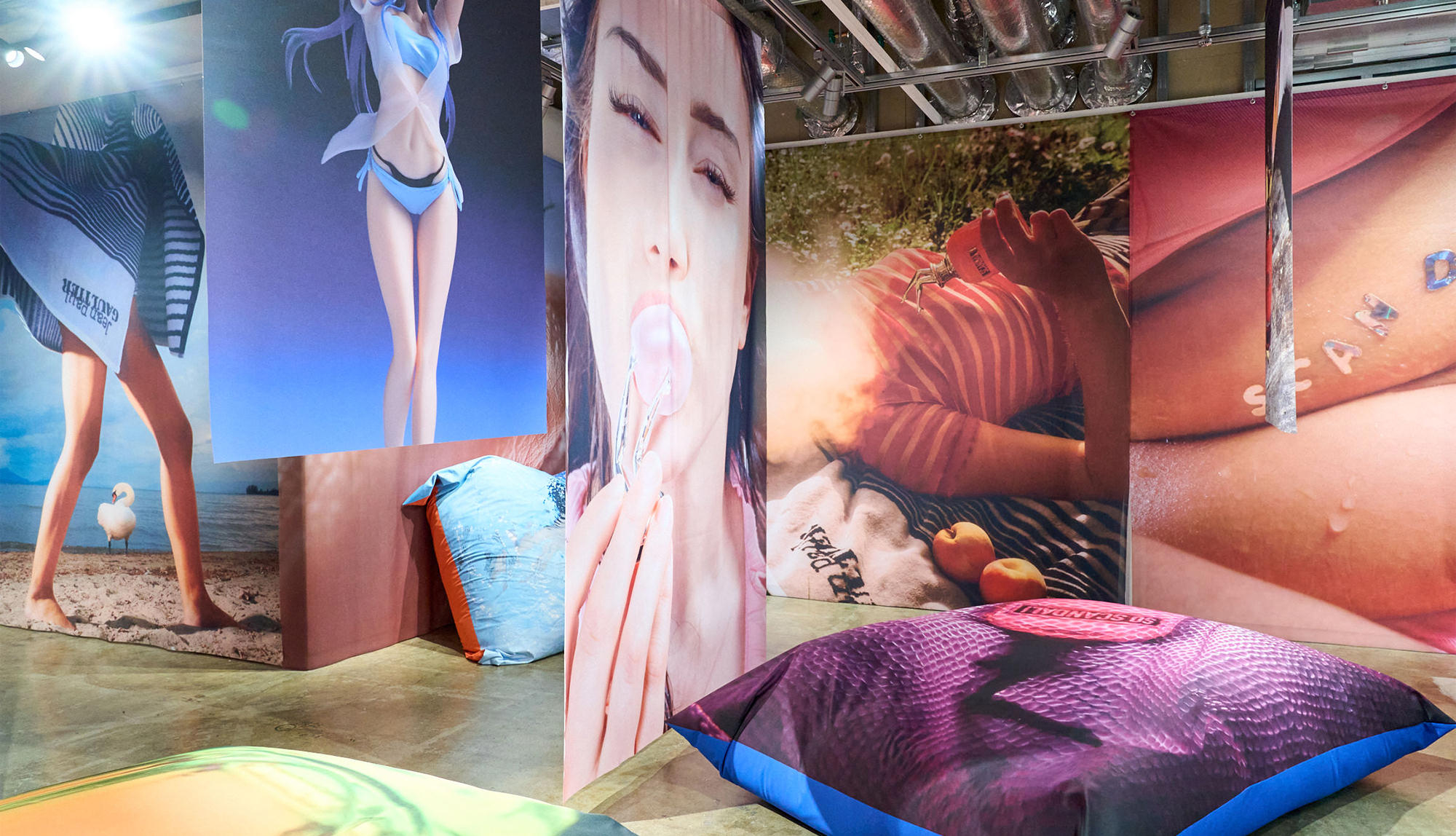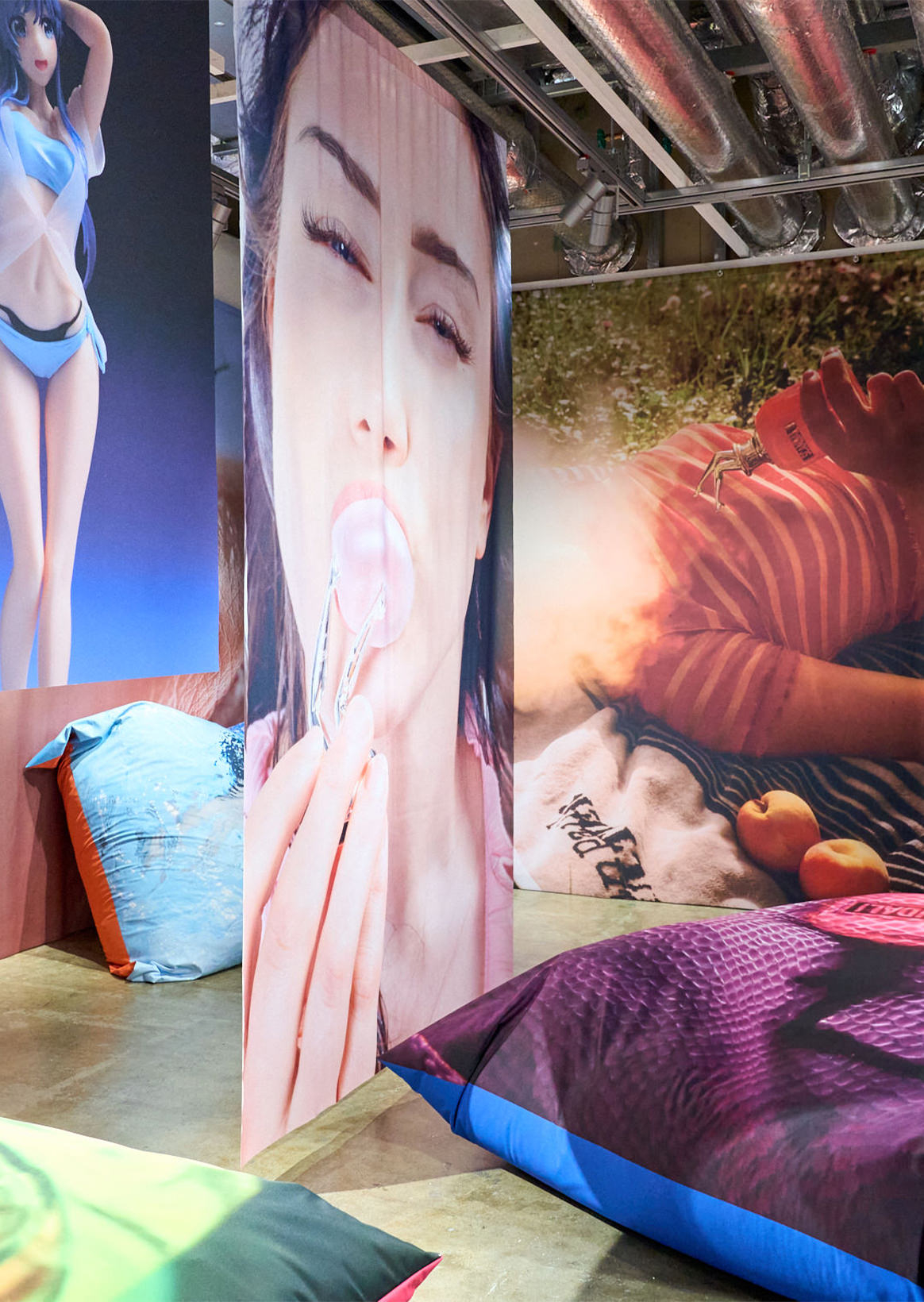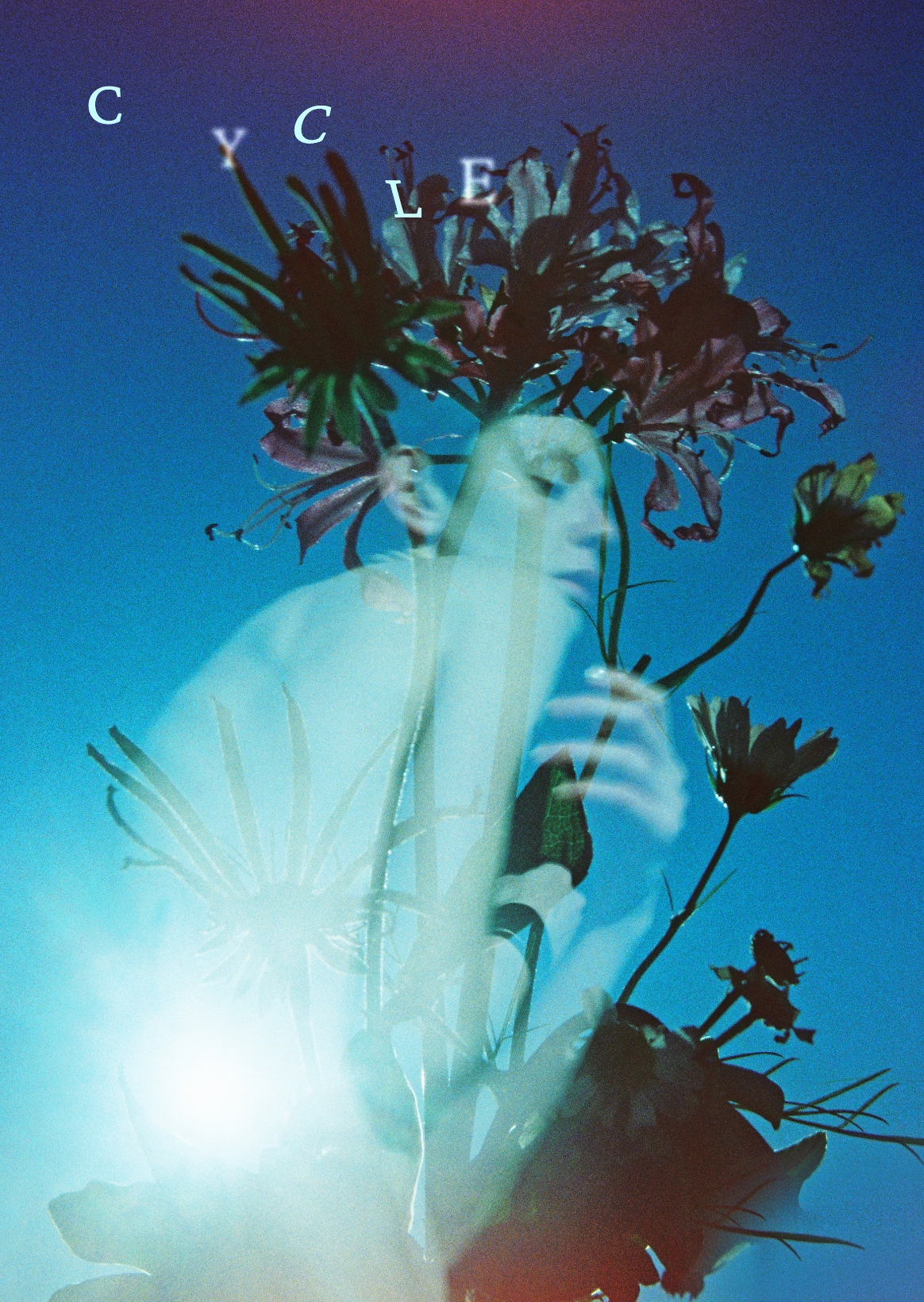- Photo
- Sachiko Saito
- Text
- Natsuko Fukushima
- Edit
- RIDE Inc.
Calypso Mahew Interview

Calypso Mahu, who teaches the basics of photography at the Lausanne University of Fine Arts (ECAL) and coordinator of Under Your Smell. This project is a collaboration with the global brand "JEAN PAUL GAULTIER". How did you lead the project to success with the students? We had an interview at "GALLERY X BY PARCO".
――How did you feel when you saw the exhibition in Tokyo? What are your thoughts?
“Under Your Smell” was very challenging. The project started with Flow Lance Tettier (Creative Director of Gaultier), Nichola Couron of Novable Magazine, and Miro Keller, Dean of ECAL Photography. When we first held this exhibition in Paris, we thought about the composition according to the space at the headquarters of Jean Paul Gaultier. It was a very large space, so I decided to print the photo on a huge cloth and display it. So in Tokyo, in the limited space of "GALLERY X BY PARCO", the team was worried about how to express this exhibition, but because of this size, I decided to fill it up with my work. For example, by adding a work that covers the wall like a wallpaper with a printed cloth, I think it was good to create a space wherever you go, wherever you go, you can encounter new works.
――Is there any difference in the exhibition in Tokyo compared to the exhibition at Paris, Basel, and the Elise Museum of Photography? Shibuya PARCO has been the center of culture, fashion and art in Japan for the past 50 years. What do you think about the significance of holding this exhibition in a space within these commercial facilities?
Of course, galleries in department stores are rare, but Shibuya PARCO attracts various fashion brands and is known as the center of culture, so it was natural to hold this exhibition in this space.
――This time, the students tried to visually express the area of fragrance called "perfume" which is not perceived visually. What advice did the students have?
I can’t see the smell of perfume. Under the direction of Flow Lance Tetier and Nichola Couron, the students first focused on the Gaultier brand to capture the image and atmosphere of the brand. In addition, we thought about the materials and colors of perfume, and we all explored what it was like to experience them using the five senses. In addition, since Gaultier is a brand that comes up with a provocative concept, I was inspired by how these brands should be.
――How long did you actually take to create your work in order to achieve this collaboration? Is there any explanation from the Gaultier side?
First of all, I explained to the students that such a project would start, and then started by conducting research on their own and having them create a mood board. There was no particular explanation from the brand side. Students will give a presentation on the mood board about how they felt about perfume and what kind of image they wanted to create, and consult with the teacher several times. The mood board is not an abstract content that conveys the atmosphere, but specifically describes the details. I will write in the image as detailed as possible, such as what model to use, makeup, styling, and colors to use. After that, the bottle of perfume actually arrived, and there is a one-week shooting period. It's called Workshop Week, and it's a very harsh week that I've always photographed. It takes about two months from the beginning of the project to the end of the shooting.
――An explanation of this exhibition is "hymn of a new definition of gender diversity and beauty." Why did you come to such a theme? The Gaultier perfume bottle itself is designed with the motif of a typical idealized male and female body, giving a slightly conservative gender feel. However, the photo works of the students have a pretty queer atmosphere. What kind of gender and beauty do you think students have?
I am 30 years old this year, and although there is a difference between my students about 10 years old, I don't usually feel that much generation gap. However, through this project, I felt that the sense of gender was different from the student generation. If I were to create a work on this project, it would have been a little more conservative gender expression. So, when I saw the atmosphere of the work submitted by the students, I was very surprised at first. The younger generation naturally breaks various stereotypes, and I think it looks very nice. Now, in terms of gender and sexuality, various ways such as bisexual, assexual, and polyamory are now visualized, and everyone has different ideas in love and work, and they choose freely as they like. It's a wonderful thing.
It is also quite recognized in the fashion industry that respects these diversity, such as various body types, and gender and sexuality. It seems that it is gradually spreading to other industries these days. I used to work well with luxury watch brands, and the model was always a white man, wearing a very large watch, and in a dignified pose was required. But in the future, we may be able to express a more queer and free atmosphere in these areas. I think customers want it too. No one wants to see the same advertisement all the time. In advertising, I think it is most important to surprise people.
――Being able to collaborate with global brands while attending university is a very fortunate environment for students. Are collaborations with these companies included in the curriculum at the university regularly, not just in Gaultier?
We collaborate with Gaultier every year. Apart from that, there is a collaboration project once a year. There are various brands that collaborate. When I was a student, I was planning with BMW. There are also various kinds of French brands, shoe brands, etc.
――For students, it is an educational and valuable initiative that leads to work after graduation. What do you think is what will be required of educational institutions in the future to foster young creators?
After graduating from our school, we want to be ready through education so that we can play an active role in society. After entering society, students will work with various companies and brands. When working with a marketing team, their goal is to sell products, but they need to live up to those expectations and demonstrate their creativity. We tell students that creativity is the most important thing in any situation, and that creativity is not pushed to death in any situation. The other is rights, right? For example, how do you work as an artist and get paid properly, or what happens to copyright to what you produce? I will teach you concrete practice of how to protect yourself as an artist in society. This is the most important thing.
――It is very important to build a career after graduation. Thank you very much.
Calypso Mahieu(ECAL)
French photographer based in Switzerland. He is an artistic deputy of ECAL (Lausanne University of Fine Arts) and teaches the basics of applied photography in the Bachelor of Photography Program. Born and raised in Paris and southern France, he moved to Lausanne, Switzerland in 2012 to study at ECAL. While at school, he received guidance from Paolo Roversi, Jürgen Teller, Walter Pfeiffer, etc. In addition to teaching, he has produced fashion editorials and campaigns for magazines and brands and has been active internationally. The work focuses on the relationship between the body, The Social Network, and posthuman. The photo is a very colorful tone inspired after the 1980s, and is produced with humor with the technopop aesthetic borrowed from Surrealism. Kalypso Maheu prefers to tell stories and anecdotes inspired by everyday life and the society surrounding her through commissions and personal projects in a poetic, fictional and delicate manner.
Jonas Pruva Interview

Jonas Pluva, a Swiss embassy in Japan, deals with communication, public diplomacy, and culture in general. In fact, the reason why this exhibition was held at “GALLERY X BY PARCO” was that the global creatives woven by ECAL, one of Europe’s leading art universities, and Jean Paul Gaultier, which has recently been re-evaluated in Japan, were realized by offerings at Shibuya PARCO. What kind of thoughts were there in the background? I spoke to Pluva, who looked at Japanese culture.
――How was this exhibition?
I am personally and proud to be able to contribute to the visualization of gender diversity and queer culture through this project. Also, I hope my Japanese friends will enjoy the wonderful talents of the entire ECAL team.
――As an embassy, what do you expect from this initiative?
2024, which marks the 160th anniversary of the establishment of diplomatic relations between Switzerland and Japan, is the ideal anniversary of the establishment of a cooperative relationship. The friendship between the two countries, which began by Swiss watchmakers and watchmakers aiming to open up new markets, is rooted in business and pioneering spirit.
Today, we are working together to shape the future by addressing issues such as sustainability, health, and diversity.
Our Public Diplomacy Program (a public activity aimed at harmony in the international community), “vibrity.swiss” offers many opportunities to think together and imagine potential solutions to contemporary challenges. “Under Your Smell” is a highlight of the 2024 vitality.swiss program.
――Why did you propose Shibuya PARCO to ECAL?
PARCO is a legendary cultural company in Shibuya, Tokyo, and Japan. Since the 1960s, we have contributed to the formation of the identity of millions of young Japanese people. Shibuya PARCO, which has always been at the forefront of social progress through fashion, art, and culture, was the perfect partner to hold this exhibition under Your Smell. This is the first time that the Embassy of Switzerland in Japan has collaborated with PARCO, and I am very proud to have the opportunity to engage with such a well-known and affinity cultural facility.
――Is there a role that PARCO would like to expect in international cultural exchange?
PARCO is a great platform for cultural exchange, and we hope to continue dialogue on themes such as creativity, diversity, cultural innovation, and social change. Japan and Switzerland have similarities in the sense that society looks a little conservative, but there is a lot of innovation and creativity in the fields of design, architecture and photography, for example. We look forward to a further leap forward as a place for innovation and creation for the future!
Jonas Pulver, Embassy of Switzerland in Japan
Director of Public Relations and Culture of the Embassy of Switzerland in Japan. After 10 years of experience in the journalism and media industry, he assumed his current position. As a reporter, columnist, and overseas correspondent for the Swiss daily Le Temps, he has reported in Japan, South Korea, India, the United States of America, Mexico, and Europe, and has also contributed to Swiss national radio, Radio France, and Courier. Since 2017, he has been working on communication, public diplomacy, and culture at the Embassy of Switzerland in Japan. Graduated from the University of Tokyo with a Master's degree in Cultural Studies. He holds a master's degree from the University of Applied Sciences and Arts in Western Switzerland and a professional qualification from the Lausanne Journalism Media Center.



